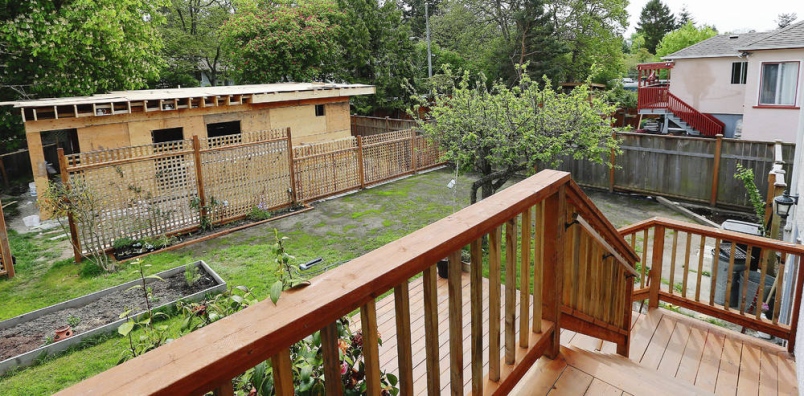Courtesy of the Times Colonist
Photo: Garden suites like this one under construction in Victoria in 2014 are considered “gentle infill,” along with row houses, townhouses, duplexes and secondary suites in homes, writes Trevor Hancock. ADRIAN LAM, TIMES COLONIST
In Canada, we are 80 per cent urbanized and spend 90 per cent of our time indoors, making the built environment one of the most important determinants of our health.
As a leader in the creation of the modern Healthy Cities and Communities movement, I continue a long tradition of considering the public-health implications of housing and urban design, which includes the ecological and social impacts of such development.
In the face of an ecological crisis that includes massive and rapid climate change, resource depletion and loss of biodiversity, and a social crisis that includes heightened inequality, insecure work and social disconnection, how do we create living places that are affordable, sustainable and good for our physical, mental and social wellbeing?
The concept of sustainable community design has been around for many decades. Not coincidentally, one of the early books on the topic — Calthorpe and Van der Ryn’s Sustainable Communities — came out in 1986, the same year the Healthy Cities project was launched in Europe. Several other urban movements are related to the theme of healthy and sustainable urban design, including Smart Growth, New Urbanism, Livable Cities, Happy Cities — the list goes on.
What they all have in common is what has more recently come to be called “gentle density.” Championed by Vancouver-based urban planner Brent Toderian, this approach is about “building smarter suburbs that are more mixed, compact, walkable, and transit friendly,” he wrote in 2013.
However, gentle density is not just for suburbs; we need “gentle infill” in the urban core. In her 2016 article on this topic, Kathleen McCormick quotes Peter Pollock of the Lincoln Institute of Land Policy in the U.S., who described the approach as “trying to find ways to make infill compatible with surroundings to achieve urban design goals and enable production of more housing.”
A 2017 article by Katie Hyslop in The Tyee discussed examples of gentle infill (also, she noted, called “sensitive” or “ground-oriented” infill) in the Lower Mainland. These “can take many forms, from building in-house secondary suites, to adding laneway homes, town/row houses, duplexes, triplexes, and quadplexes to a single family home lot.” What characterises such an approach is that “nothing is higher than stacked townhouses,” she wrote.
Many gentle density projects are multi-family dwellings, but on a human scale — not large, impersonal highrises. Vancouver-based Charles Montgomery and his team at Happy City have been looking at how to design Happy Homes: “multi-family places where people are happier, healthier and more connected.”
They found that “mixed-use neighbourhoods that encourage walking are most likely to be associated with positive social encounters and a strong sense of community” and that “access to nature is strongly linked to positive neighbourhood relationships and trust among community members.”
But while the physical design is important, so, too, is the social design. Among the 10 principles they identified are the need to create opportunities for people to participate in the design and management of their project and do meaningful and enjoyable things together.
There are a number of environmental and social benefits to this approach. The environmental benefits include avoiding the need for further destructive urban sprawl, creating smaller and more energy-efficient homes that require fewer resources to build and operate, and car-free or low-car-dependency living that reduces greenhouse gas and other pollutant emissions.
The social benefits include more affordable housing which, if built in walkable, bikeable neighbourhoods, reduces the need for car ownership, as I discussed last week. This frees up income for other purposes. Other social benefits include less time spent commuting and more convenient access to daily necessities in a “15-minute” neighbourhood.
All of these environmental and social benefits result in health co-benefits. These include less air pollution and climate change, more physical activity and reduced obesity, and more social connection. The good news is that there are a growing number of small-scale gentle infill projects being proposed and developed in the region’s core, with potential benefits both locally and regionally.
So it is time to consider the first recommendation of a recent declaration endorsed by many leading Canadian urbanists that municipalities should update their current zoning policies to allow ”gentle density to be built, as-of-right, alongside houses in low-rise residential neighbourhoods.”
thancock@uvic.ca
Dr. Trevor Hancock is a retired professor and senior scholar at the University of Victoria’s School of Public Health and Social Policy.
